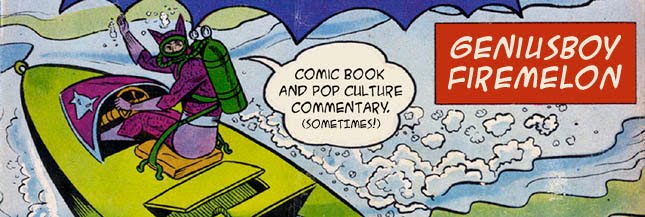 This week, Chad Nevett and I talk about the new DC executive restructuring/promotions even though we really have no insight into the topic whatsoever. But somehow, I make it all about me.
This week, Chad Nevett and I talk about the new DC executive restructuring/promotions even though we really have no insight into the topic whatsoever. But somehow, I make it all about me.We also talk "Joe the Barbarian" and Fraction's Uncanny effort to bring the Morrison x-continuity back into play.
It's kind of a shorter episode, because I had to write a whole bunch of stuff this weekend, and so I ditched Chad a bit early.
Oh, and we talk about curling.
Listen: Splash Page Podcast Episode 5!

8 comments:
Great podcast, guys.
I'm not sure I agree with your characterization of Batman & Robin, though. I know what you're saying in that the series is more straightforward action-adventure-y than Morrison's previous stuff, but there is a LOT of subtext and a LOT of allusions...it's just that Morrison hasn't made any of this stuff important on the narrative level...yet. New readers can follow the series relatively easily, not realizing that El Penitente appears to be Dr. Hurt, that Pyg and Flamingo appeared in Batman #666, that the domino motif takes off from the "game" motifs of the Black Glove, etc. There have been a TON of references and "plays" off of Grant's past Batman stuff, as well as several substantive literary allusions (to G.B. Shaw, Milton, Blake and Yeats). It's just that the reader doesn't NEED to recognize this stuff in order to enjoy the surface-level action. That's a change from the style(s) Morrison had been using in Final Crisis and Batman (esp. the dense Tony Daniel issues). You don't need to recognize the subtext and veiled allusions in B&R--but there IS plenty of that stuff there. With Joe the Barbarian, though, it seems like there's zero subtext whatsoever. So, on one level B&R and JtB are similar in that they're relatively easy to read. But B&R DOES run much deeper, if the reader knows where to look.
I'm not so sure this is so much a reaction to reader response of Final Crisis. I think it's just a natural transition on Morrison's part, of wanting to do something different, since you can't really push the ball any further in the direction he was going ("channel-surfing comics").
I'd recommend the following links, in order to understand the subtext of B&R better:
http://rikdad.blogspot.com
http://www.4thletter.net/2009/11/batman-robin-the-facets-of-the-joker/
Anyway, good show, guys. I agree with many of your opinions especially, Tim.
Well, my opinions ARE the right ones. So you have chosen wisely.
...I'm going to focus on us agreeing 98% of the time...
A point of note about Joe The Barbarian:
Joe the Barbarian is more than just a fantasy adventure story, but its subtext is not as immediate as a lot of Morrison's other works.
While it's unfair of me to make assumptions about the story based on only two issues, it seems evident to me that one of the central concerns with the text is the fixation on the gap between youth and adulthood. We see Joe struggling with facing the realities of the real world in the first issue, and his retreat to his attic room, a sort of fantastical juvenile space--really, the idealized boy's bedroom.
These apparent hallucinations stem from an illness, and without an adult to provide care, he is required to do it himself. The stark difference between his fantastical toy world and the real world is a parable for the difference between Youth and Manhood. Many panels show this fantastic world, and I'd be interested to see if in the later issues we see more and more of the real world and his struggle to get to his insulin is a struggle to reach manhood. These toys are a distraction, in one sense--this fantasy world makes it extraordinarily difficult for him to fulfill the real, adult need he has.
There's more that I won't go into, because It's already the start of an essay there and I have actual school work to do. So, just some food for thought I suppose.
Also, I loved We3.
But isn't EVERY fantasy story about growing up? That's the substructure of all heroic quest tales. It mirrors leaving the home and going out into the world of adults.
Well Tim, that's a good point. I wouldn't say ALL are, but certainly most for young adults. So perhaps this is an exercise in writing such a story? Perhaps it's something to share with your kids?
perhaps my problem is that I was looking at this title as a book for adults, when really it's a book for kids.
Oh, yeah, that is how I teach the heroic quest story to students. We talk about how it's all a metaphor for growing up. I mean, the students are literally in the "mentoring" phase before they cross the "threshold" into the unknown world. The entire primal structure of the thing implicitly deals with the progress from youth to adulthood.
Interestingly enough, it does point to the fact that Joe doesn't have that mentor character in his story -- and maybe that's part of its theme. His mom reminds him about some stuff, but doesn't provide direct mentoring to prepare him for the journey he embarks on. So it's about the hero without guidance. A metaphor for the 21st century child who is alone in the world, fending for himself. Or something.
I agree completely. Sort of the whole 'millennial generation' latch-key kid approach to retelling the story.
I'm just used to looking at monomyth/hero's journey story from my selected readings in Adult lit, as I don't read a lot of YA novels.
Post a Comment